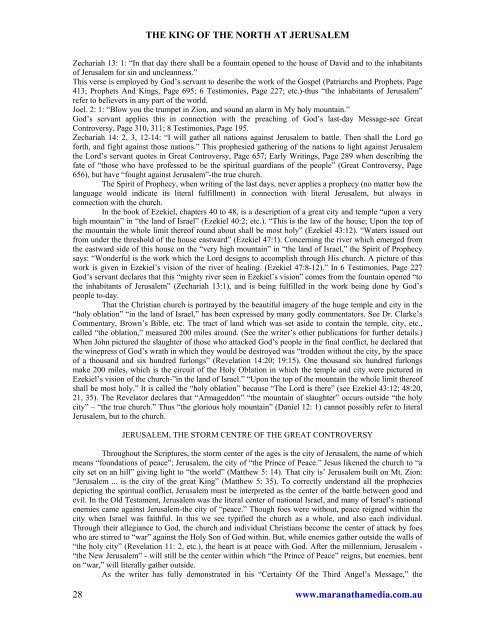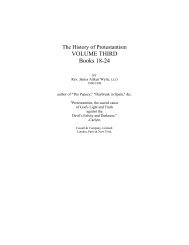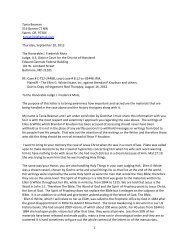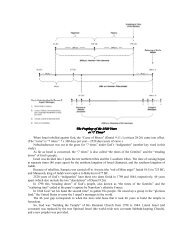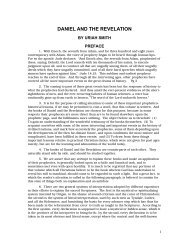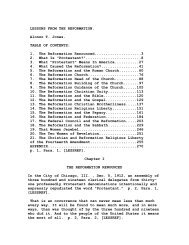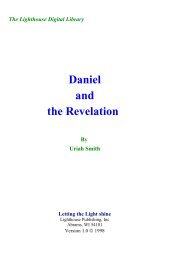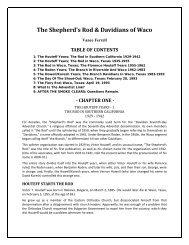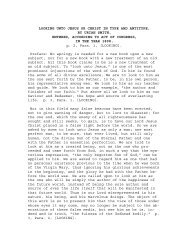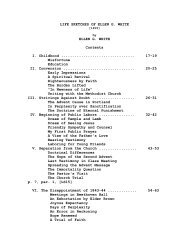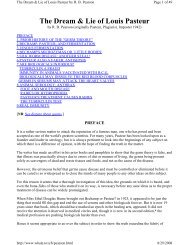Kings Of The North - Amazing Discoveries
Kings Of The North - Amazing Discoveries
Kings Of The North - Amazing Discoveries
Create successful ePaper yourself
Turn your PDF publications into a flip-book with our unique Google optimized e-Paper software.
THE KING OF THE NORTH AT JERUSALEM<br />
Zechariah 13: 1: “In that day there shall be a fountain opened to the house of David and to the inhabitants<br />
of Jerusalem for sin and uncleanness.”<br />
This verse is employed by God’s servant to describe the work of the Gospel (Patriarchs and Prophets, Page<br />
413; Prophets And <strong>Kings</strong>, Page 695; 6 Testimonies, Page 227; etc.)-thus “the inhabitants of Jerusalem”<br />
refer to believers in any part of the world.<br />
Joel. 2: 1: “Blow you the trumpet in Zion, and sound an alarm in My holy mountain.”<br />
God’s servant applies this in connection with the preaching of God’s last-day Message-see Great<br />
Controversy, Page 310, 311; 8 Testimonies, Page 195.<br />
Zechariah 14: 2, 3, 12-14: “I will gather all nations against Jerusalem to battle. <strong>The</strong>n shall the Lord go<br />
forth, and fight against those nations.” This prophesied gathering of the nations to light against Jerusalem<br />
the Lord’s servant quotes in Great Controversy, Page 657; Early Writings, Page 289 when describing the<br />
fate of “those who have professed to be the spiritual guardians of the people” (Great Controversy, Page<br />
656), but have “fought against Jerusalem”-the true church.<br />
<strong>The</strong> Spirit of Prophecy, when writing of the last days, never applies a prophecy (no matter how the<br />
language would indicate its literal fulfillment) in connection with literal Jerusalem, but always in<br />
connection with the church.<br />
In the book of Ezekiel, chapters 40 to 48, is a description of a great city and temple “upon a very<br />
high mountain” in “the land of Israel” (Ezekiel 40:2; etc.). “This is the law of the house; Upon the top of<br />
the mountain the whole limit thereof round about shall be most holy” (Ezekiel 43:12). “Waters issued out<br />
from under the threshold of the house eastward” (Ezekiel 47:1). Concerning the river which emerged from<br />
the eastward side of this house on the “very high mountain” in “the land of Israel,” the Spirit of Prophecy<br />
says: “Wonderful is the work which the Lord designs to accomplish through His church. A picture of this<br />
work is given in Ezekiel’s vision of the river of healing. (Ezekiel 47:8-12).” In 6 Testimonies, Page 227<br />
God’s servant declares that this “mighty river seen in Ezekiel’s vision” comes from the fountain opened “to<br />
the inhabitants of Jerusalem” (Zechariah 13:1), and is being fulfilled in the work being done by God’s<br />
people to-day.<br />
That the Christian church is portrayed by the beautiful imagery of the huge temple and city in the<br />
“holy oblation” “in the land of Israel,” has been expressed by many godly commentators. See Dr. Clarke’s<br />
Commentary, Brown’s Bible, etc. <strong>The</strong> tract of land which was set aside to contain the temple, city, etc.,<br />
called “the oblation,” measured 200 miles around. (See the writer’s other publications for further details.)<br />
When John pictured the slaughter of those who attacked God’s people in the final conflict, he declared that<br />
the winepress of God’s wrath in which they would be destroyed was “trodden without the city, by the space<br />
of a thousand and six hundred furlongs” (Revelation 14:20; 19:15). One thousand six hundred furlongs<br />
make 200 miles, which is the circuit of the Holy Oblation in which the temple and city were pictured in<br />
Ezekiel’s vision of the church-”in the land of Israel.” “Upon the top of the mountain the whole limit thereof<br />
shall be most holy.” It is called the “holy oblation” because “<strong>The</strong> Lord is there” (see Ezekiel 43:12; 48:20,<br />
21, 35). <strong>The</strong> Revelator declares that “Armageddon” “the mountain of slaughter” occurs outside “the holy<br />
city” – “the true church.” Thus “the glorious holy mountain” (Daniel 12: 1) cannot possibly refer to literal<br />
Jerusalem, but to the church.<br />
28<br />
JERUSALEM, THE STORM CENTRE OF THE GREAT CONTROVERSY<br />
Throughout the Scriptures, the storm center of the ages is the city of Jerusalem, the name of which<br />
means “foundations of peace”; Jerusalem, the city of “the Prince of Peace.” Jesus likened the church to “a<br />
city set on an hill” giving light to “the world” (Matthew 5: 14). That city is’ Jerusalem built on Mt. Zion:<br />
“Jerusalem ... is the city of the great King” (Matthew 5: 35). To correctly understand all the prophecies<br />
depicting the spiritual conflict, Jerusalem must be interpreted as the center of the battle between good and<br />
evil. In the Old Testament, Jerusalem was the literal center of national Israel, and many of Israel’s national<br />
enemies came against Jerusalem-the city of “peace.” Though foes were without, peace reigned within the<br />
city when Israel was faithful. In this we see typified the church as a whole, and also each individual.<br />
Through their allegiance to God, the church and individual Christians become the center of attack by foes<br />
who are stirred to “war” against the Holy Son of God within. But, while enemies gather outside the walls of<br />
“the holy city” (Revelation 11: 2, etc.), the heart is at peace with God. After the millennium, Jerusalem -<br />
“the New Jerusalem” - will still be the center within which “the Prince of Peace” reigns, but enemies, bent<br />
on “war,” will literally gather outside.<br />
As the writer has fully demonstrated in his “Certainty <strong>Of</strong> the Third Angel’s Message,” the<br />
www.maranathamedia.com.au


